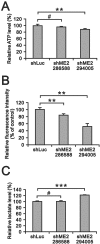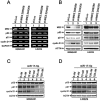The mechanisms of malic enzyme 2 in the tumorigenesis of human gliomas
- PMID: 27166188
- PMCID: PMC5173072
- DOI: 10.18632/oncotarget.9190
The mechanisms of malic enzyme 2 in the tumorigenesis of human gliomas
Abstract
The high level of resistance of glioblastoma multiforme (GBM) to currently used chemotherapies and other conventional therapies, its invasive characteristics and the presence of stem-like cells are the major factors that make the treatment of GBM difficult. Recent studies have demonstrated that the homeostasis of energy metabolism, glycolysis and mitochondrial oxidation of glucose are important for GBM cell growth and chemo-resistance. However, it is not clear which specific gene(s) are involved in the homeostasis of energy metabolism and invasiveness of GBM cells. We performed a preliminary analysis of data obtained from Gene Expression Omnibus profiles and determined that malic enzyme 2 (ME2) expression was positively associated with WHO grade in human primary gliomas. Hence, we evaluated the detailed working mechanisms of ME2 in human GBM cell processes, including proliferation, cell cycle, invasion, migration, ROS, and ATP production. Our data demonstrated that ME2 was involved in GBM growth, invasion and migration. ME2 has two cofactors, NAD+ or NADP+, which are used to produce NADH and NADPH for ATP production and ROS clearance, respectively. If the catalytic activity of ME2 is determined to be critical for its roles in GBM growth, invasion and migration, small molecule inhibitors of ME2 may be valuable drugs for GBM therapy. We hope that our current data provides a candidate treatment strategy for GBM.
Keywords: glioblastoma multiforme; malic enzyme 2; p53; reactive oxygen species; tumorigenesis.
Conflict of interest statement
The authors declare no conflicts of interest.
Figures








Similar articles
-
SLC7A11 Overexpression in Glioblastoma Is Associated with Increased Cancer Stem Cell-Like Properties.Stem Cells Dev. 2017 Sep 1;26(17):1236-1246. doi: 10.1089/scd.2017.0123. Epub 2017 Jul 27. Stem Cells Dev. 2017. PMID: 28610554 Free PMC article.
-
A novel lncRNA MDHDH suppresses glioblastoma multiforme by acting as a scaffold for MDH2 and PSMA1 to regulate NAD+ metabolism and autophagy.J Exp Clin Cancer Res. 2022 Dec 17;41(1):349. doi: 10.1186/s13046-022-02543-7. J Exp Clin Cancer Res. 2022. PMID: 36527092 Free PMC article.
-
Human mitochondrial NAD(P)(+)-dependent malic enzyme participates in cutaneous melanoma progression and invasion.J Invest Dermatol. 2015 Mar;135(3):807-815. doi: 10.1038/jid.2014.385. Epub 2014 Sep 9. J Invest Dermatol. 2015. PMID: 25202825
-
The role of Myc and let-7a in glioblastoma, glucose metabolism and response to therapy.Arch Biochem Biophys. 2015 Aug 15;580:84-92. doi: 10.1016/j.abb.2015.07.005. Epub 2015 Jul 4. Arch Biochem Biophys. 2015. PMID: 26151775 Review.
-
miRNA Multiplayers in glioma. From bench to bedside.Acta Biochim Pol. 2015;62(3):353-65. doi: 10.18388/abp.2015_1072. Epub 2015 Aug 26. Acta Biochim Pol. 2015. PMID: 26307768 Review.
Cited by
-
Malic enzyme 1 (ME1) in the biology of cancer: it is not just intermediary metabolism.J Mol Endocrinol. 2020 Nov;65(4):R77-R90. doi: 10.1530/JME-20-0176. J Mol Endocrinol. 2020. PMID: 33064660 Free PMC article. Review.
-
The Metabolic Fates of Pyruvate in Normal and Neoplastic Cells.Cells. 2021 Mar 30;10(4):762. doi: 10.3390/cells10040762. Cells. 2021. PMID: 33808495 Free PMC article. Review.
-
ME2 Promotes Proneural-Mesenchymal Transition and Lipogenesis in Glioblastoma.Front Oncol. 2021 Jul 23;11:715593. doi: 10.3389/fonc.2021.715593. eCollection 2021. Front Oncol. 2021. PMID: 34381734 Free PMC article.
-
Extracellular citrate and metabolic adaptations of cancer cells.Cancer Metastasis Rev. 2021 Dec;40(4):1073-1091. doi: 10.1007/s10555-021-10007-1. Epub 2021 Dec 21. Cancer Metastasis Rev. 2021. PMID: 34932167 Free PMC article. Review.
-
Convergent Approaches to Delineate the Metabolic Regulation of Tumor Invasion by Hyaluronic Acid Biosynthesis.Adv Healthc Mater. 2023 Jun;12(14):e2202224. doi: 10.1002/adhm.202202224. Epub 2022 Dec 21. Adv Healthc Mater. 2023. PMID: 36479976 Free PMC article.
References
-
- Furnari FB, Fenton T, Bachoo RM, Mukasa A, Stommel JM, Stegh A, Hahn WC, Ligon KL, Louis DN, Brennan C, Chin L, DePinho RA, Cavenee WK. Malignant astrocytic glioma: genetics, biology, and paths to treatment. Genes & development. 2007;21:2683–2710. - PubMed
-
- Kumar PP, Good RR, Jones EO, Patil AA, Leibrock LG, McComb RD. Survival of patients with glioblastoma multiforme treated by intraoperative high-activity cobalt 60 endocurietherapy. Cancer. 1989;64:1409–1413. - PubMed
MeSH terms
Substances
LinkOut - more resources
Full Text Sources
Other Literature Sources
Medical
Molecular Biology Databases
Research Materials
Miscellaneous

